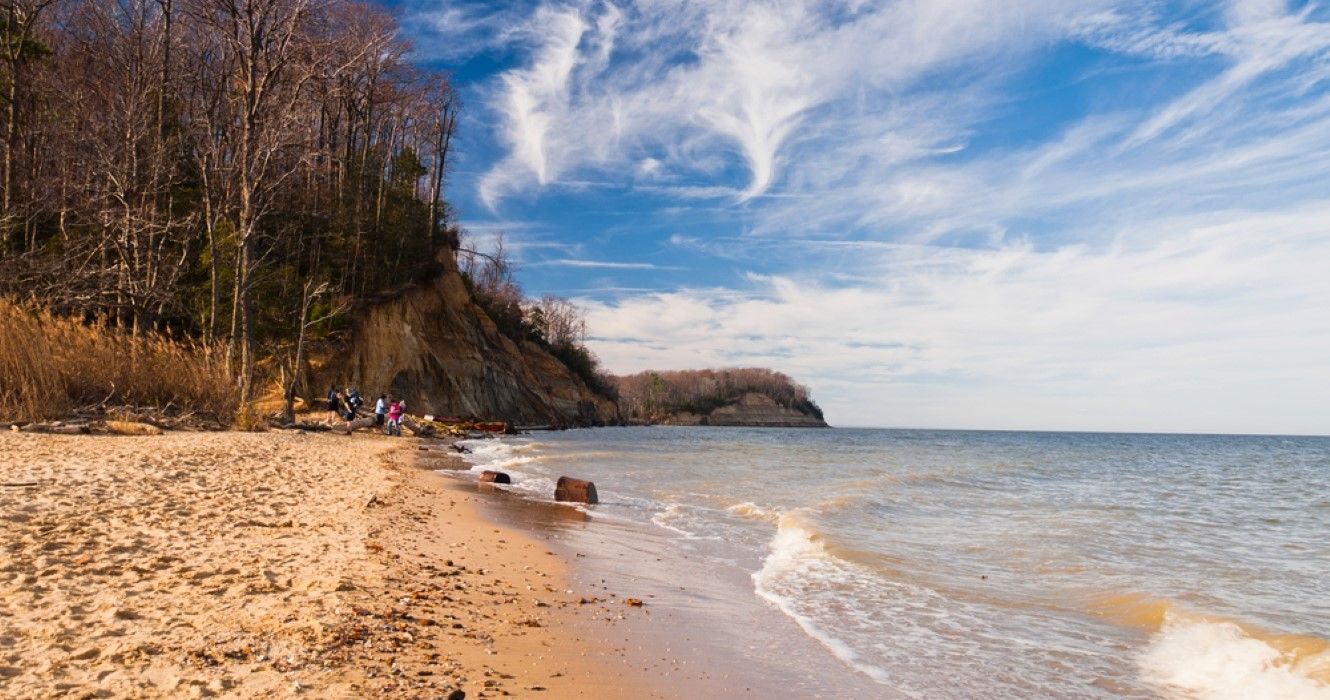Quick Links
Nestled along Chesapeake Bay's western shoreline lies a geological marvel that has taken millions of years to form. Calvert Cliffs State Park is home to massive cliffs that date back millions of years. The destination is full of adventure, where visitors can hike, hunt, fish, swim, and even have a picnic at the park.
The scenic splendor of Calvert Cliffs makes it a sought-after tourist attraction in Maryland, thanks to its forest trails, coastal cliffs, and beach rich in prehistoric fossils. Here is important information every visitor needs to be equipped with before visiting this coastal scenery.
The Land Before Time
Calvert Cliffs State Park gives tourists a peek into prehistoric Maryland. The honey-sand beach stretches for about 24 miles along the Chesapeake Bay shoreline. The park is named after the massive cliffs that were formed over 10 to 20 million years ago. Upon entrance, the cliff and waters are not quite visible, which may seem underwhelming at first glance. But, after exiting the parking lot, the scent of the forest trees and the sound of frogs at a distance awakens the adventurous senses.
Tourists who haven't yet been to Calvert Cliffs National Park are missing out on Maryland's hidden gem. The day-use park boasts an array of outdoor activities, including hiking, swimming, and high-intensity fossil hunting. Additionally, it's not unusual to see locals and tourists on a horse tour in this park.
The beach's real estate and smoothness depend on the most recent storm's activity. The water is knee to waist high at high tide, and the beach isn't crowded. However, swimming is at your own risk, as the park has no lifeguards or nettle nets.
- Entry Fee: $5 per person/vehicle, $7 for out-of-state-visitor
During the peak season, the park can get crowded. For a more enjoyable trip, planning early during a weekday trip or visiting on the weekend is recommended.
Calvert Cliffs Hike
Hiking is one of Calvert Cliffs' main attractions. With about 1.8-to-3.6-miles of hike trails and fossilized treasures awaiting curious hikers, there is a lot to explore in this adventurous terrain. The hike trails crisscross the State Park, and Red Trail is the visitors' favorite. The hiking trail consists of boardwalks, sandy soil, and well-marked-level grounds, making it easy for novice hikers to maneuver.
The Red Tail hike takes an average hiker about 45 minutes to complete. During the adventure, tourists can enjoy the sizzling sights of trickling streams, lily pads in bloom, and various species of birds. The captivating surroundings are enough to make a hiker forget they are headed to the beach adjacent to the cliffs. The path can sometimes be narrow due to crisscrossing trees, adding a fun challenge as one walks through the wetlands. Biking is restricted to the service road in the state park.
At the beach, visitors can relax in the ambient scenery, which features views of the dramatic cliffs. Formed more than 10 million years ago when all of Southern Maryland was covered by warm sea waters, the Miocene-era cliffs came to being after the shallow sea receded over time. The awe-inspiring landforms tower over 100 feet above the shoreline.
Although the park is family-friendly, it's not safe to try climbing the cliffs, as the unpredictable erosion makes the spots unsafe for children and inexperienced hikers.
Shark Tooth Hunting At Calvert Cliffs
Calvert Cliffs harbor a vast collection of fossiliferous exposures. This prehistoric heritage is one of the major attractions of this destination. When planning to visit Calvert Cliffs, think of shark-tooth hunting. At Calvert Cliffs, all a tourist needs is a shovel and some patience to find a mega-sized seashell or a shark tooth.
The aftermath of the Miocene epoch is the reason behind these outstanding relics. As the water receded about 18 million years ago and revealed the terrain below, a wide range of remains became exposed. These included prehistoric land and sea life. Calvert Cliff is home to fossils of over 600 species that have been discovered over the years. Some examples of marine animal fossils include whales, rays, seals, and sea turtles. In addition, tourists can bump into fossils of predecessors of the present-day land animals like camels, wooly rhinos, and peccary. However, most remains are bone fragments.
Fossil hunting and collection are only allowed on Calvert Cliff's beach. Tourists are not allowed to dig for fossil remains embedded into the cliffs.
Things to Know Before Visiting Calvert Cliffs
If planning a trip to Calvert Cliffs is a unique relaxation spot for outdoor lovers of all ages and experience levels. Here is what visitors need to know before visiting Calvert Cliff.
- Calvert Cliff is a day-use park. One can find picnic tables and a few youth group sites suitable for camping.
- Pets are allowed here, but owners have to walk them on a leash.
- There are no stores near the park. Visitors are encouraged to bring their refreshments.
- The only fishing spot available is at the pond near the picnic area. However, a Maryland Freshwater fishing license is required for anyone above 16 years.
Calvert Cliff is an excellent place to spend time with friends and family. Whether on a weekend vacation or looking to improve your hiking and hunting skills, the park delivers memorable experiences. With proper preparation and observation of the rules, the destination is certainly worth a visit.

